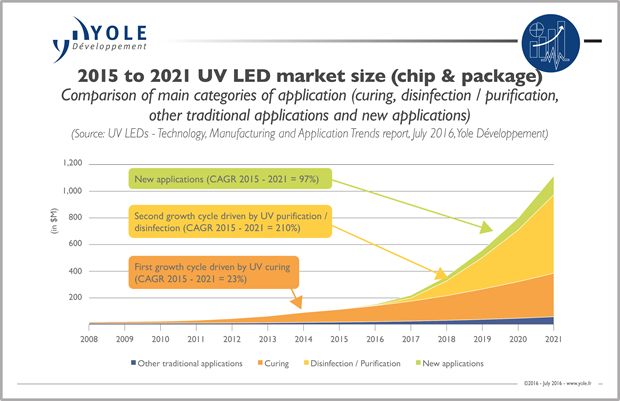UV disinfection/purification market take over the UV curing market
In a short term, UV curing will drive the UV LED market, announces Yole Développement (Yole) in its new LED report entitled UV LEDs: Technology, Manufacturing and Applications Trends. But UVC LED’s recent price reduction will see the UV disinfection/purification market take over the UV curing market by 2019/2020. In this context, Yole’s analysts expect the UVC LED market to strongly grow from $7m in 2015 to $610m by 2021.
With an increased penetration rate in all applications, the UVA LED market will grow from $107m in 2015 to $357m by 2021. In addition to a moderated growth due to price pressure, Yole announces a very strong increase in number of devices.
Under this new UV LED report, 2016 edition, Yole details the latest technology and market trends. This comprehensive survey provides a deep understanding of the UV lamp business and its technological transition to UV LEDs. It is a thorough analysis of each UV lamp application (UVA/UVB/UVC) with a specific focus on UV curing, UV disinfection/purification and analytical instruments using UV light. Yole’s report highlights the global UV LED industry trends, from substrate to system and details the main challenges and axis of research.
“The UVC LED industry is still small but strong growth is expected in the next 18 months due to dramatic price reductions,” explains Pierrick Boulay, Market and Technology Analyst, LED & OLED at Yole. And he adds: “In 2016 prices are 1/8-1/10 of what they were in 2015.” This has been triggered by the industry’s development, its transition to mass production and improved device performance. With most of the industry believing that $1-$4/mW is the price that would trigger mass market adoption we are getting close to a UVC LED market boom. Another positive sign is that most UVC LED manufacturers are now focusing on developing cost-effective solutions rather than improving device power output.

In parallel, the UVC LED industry continues to work on increasing lifetime and developing lower wavelength devices, below 280nm. In parallel, UVA LEDs continue to progress in the UV curing space. “Continuous improvement of device performance coupled with price reduction has allowed the technology to be increasingly adopted in UV curing applications,” asserts Pars Mukish, Business Unit Manager, at Yole.“Penetration of UV LEDs is increasing but we observe differences in adoption rates depending on application.” Small size and low speed applications like spot adhesive and digital inkjets have the highest adoption rate, and most new developments use UV LEDs. This is due to the small module size and low irradiance level needed that limits the extra cost of integrating UV LEDs compared to the total price of systems like inkjet printers. On the other hand, applications that need high speed processes and/or high levels of irradiance such as screen printing or coating applications have lower adoption rates. This is because UV LED performance is not yet good enough to fully replace traditional mercury lamps.
“Today UVA still represents the largest UV LED market but this trend could change in the future as UV LED performances increase,” announces Yole’ analysts. UV LEDs also enable new applications inaccessible to UV lamp. If these new applications take off, they could represent and additional revenue of nearly $143m in 2021.
Yole’s UV LED report highlights the market structure, UV LED market drivers and associated technical challenges, recent trends and new applications created by UV LEDs. It also includes UV LED market size split by application, and much more.







